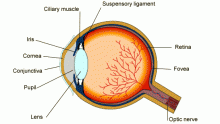Eye problems due to Aniridia
1. Dry eye. "Dry Eye" is defined as a violation of the tear of the eye.
Symptoms of dry eye - itching, burning, irritation, redness, blurred vision or tearing and increased discomfort after periods of reading, watching TV or using the computer.
2. Defects in the cornea. The cornea, the transparent dome-shaped formation that covers the front of the eye. Abnormal gene PAX6 can cause abnormalities in the cornea. This usually results in irregular corneal inflammation and subsequent corneal opacity, from the periphery and gradually progressed in the central part of the cornea. This can happen in two years.
For the treatment of corneal opacities and pannus with loss of vision, there are corneal transplants, but there is the possibility of rejection of the implant.
Microcornea is another anomaly of the cornea associated with aniridia. Microcornea appears as a reduced diameter of the cornea.
3. Glaucoma.
Glaucoma can occur at any age from infancy to old age. In connection with the lifetime risk of glaucoma, aniridia patients should be screened regularly by doctors.
Treatment of glaucoma can be medical or surgical. Drug therapy can be successful in the beginning, but most patients will require surgery.
4. Anomalies of the lens. It can be a cataract (clouding) and subluxation (partial lens is shifted from its normal position).
A cataract occurs in 50% -85% of patients, usually during the first two decades of life. If the opacity leads to a deterioration of visual function, cataract operations are needed.
Subluxation of the lens may occur in 56% of patients with aniridia. This may lead to decreased vision.
5. Nystagmus. Nystagmus is involuntary eye movement. It is present in most patients with aniridia.
6. Strabismus. Strabismus is a condition in which the patient cant align both eyes simultaneously in a normal position.
7. Photophobia. Photophobia - sensitivity to light during normal lighting. Normal human have iris, that controls the amount of light entering the eye. Because of the lack of development of the iris in patients with aniridia, the eye gets an excessive amount of light, so patients try to close their eyes to reduce the light, entering the eye.
8. Ptosis . Ptosis is a condition in which the eyelid droops from normal position. Sometimes aniridia patients have it from birth.
9. Amblyopia (Greek) means "weak vision." This is a condition in which the vision is reduced, but no cause can be detected during an eye examination. According to studies, amblyopia occurs in 37% of patients with aniridia.
Early detection and treatment of this disease is very important.
The main aniridia problems – saving vision and patient`s health. It can be done by regular healt monitorings.



